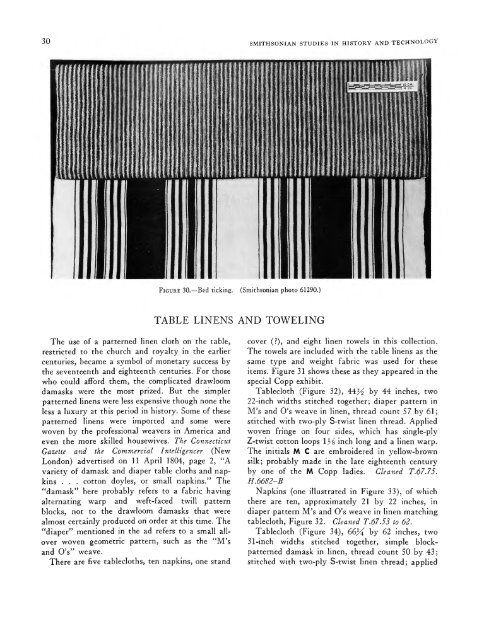The Copp Family Textiles - Smithsonian Institution Libraries
The Copp Family Textiles - Smithsonian Institution Libraries
The Copp Family Textiles - Smithsonian Institution Libraries
Create successful ePaper yourself
Turn your PDF publications into a flip-book with our unique Google optimized e-Paper software.
30 SMITHSONIAN STUDIES IN HISTORY AND TECHNOLOGY<br />
<strong>The</strong> use of a patterned linen cloth on the table,<br />
restricted to the church and royalty in the earlier<br />
centuries, became a symbol of monetary success by<br />
the seventeenth and eighteenth centuries. For those<br />
who could afford them, the complicated drawloom<br />
damasks were the most prized. But the simpler<br />
patterned linens were less expensive though none the<br />
less a luxury at this period in history. Some of these<br />
patterned linens were imported and some were<br />
woven by the professional weavers in America and<br />
even the more skilled housewives. <strong>The</strong> Connecticut<br />
Gazette and the Commercial Intelligencer (New<br />
London) advertised on 11 April 1804, page 2, "A<br />
variety of damask and diaper table cloths and napkins<br />
. . . cotton doyles, or small napkins." <strong>The</strong><br />
"damask" here probably refers to a fabric having<br />
alternating warp and weft-faced twill pattern<br />
blocks, not to the drawloom damasks that were<br />
almost certainly produced on order at this time. <strong>The</strong><br />
"diaper" mentioned in the ad refers to a small allover<br />
woven geometric pattern, such as the "M's<br />
and O's" weave.<br />
<strong>The</strong>re are five tablecloths, ten napkins, one stand<br />
FIGURE 30. — Bed ticking. (<strong>Smithsonian</strong> photo 61290.)<br />
TABLE LINENS AND TOWELING<br />
cover (?), and eight linen towels in this collection.<br />
<strong>The</strong> towels are included with the table linens as the<br />
same type and weight fabric was used for these<br />
items. Figure 31 shows these as they appeared in the<br />
special <strong>Copp</strong> exhibit.<br />
Tablecloth (Figure 32), 44;% by 44 inches, two<br />
22-inch widths stitched together; diaper pattern in<br />
M's and O's weave in linen, thread count 57 by 61;<br />
stitched with two-ply S-twist linen thread. Applied<br />
woven fringe on four sides, which has single-ply<br />
Z-twist cotton loops 1%8 inch long and a linen warp.<br />
<strong>The</strong> initials M C are embroidered in yellow-brown<br />
silk; probably made in the late eighteenth century<br />
by one of the M <strong>Copp</strong> ladies. Cleaned T.67.75.<br />
H.6682-B<br />
Napkins (one illustrated in Figure 33), of which<br />
there are ten, approximately 21 by 22 inches, in<br />
diaper pattern M's and O's weave in linen matching<br />
tablecloth, Figure 32. Cleaned T.67.53 to 62.<br />
Tablecloth (Figure 34), 66)4 by 62 inches, two<br />
31-mch widths stitched together, simple blockpatterned<br />
damask in linen, thread count 50 by 43;<br />
stitched with two-ply S-twist linen thread; applied

















